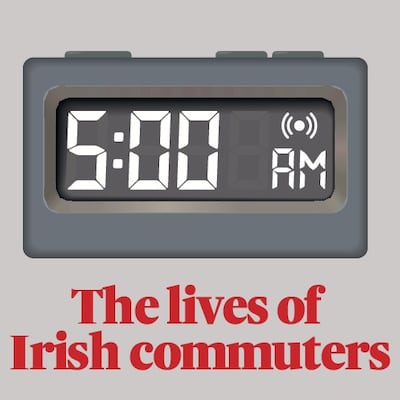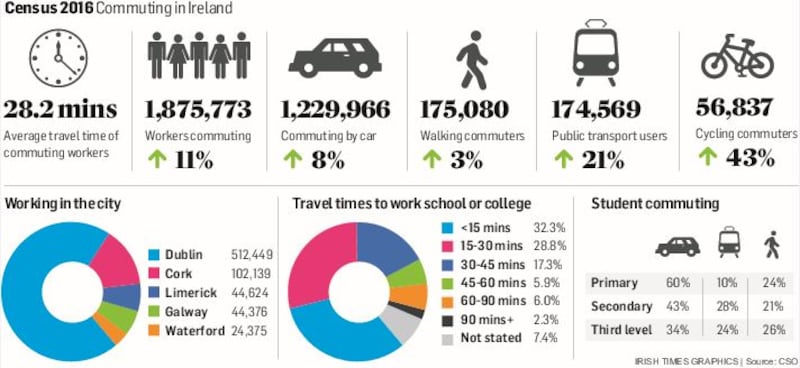
One in 10 commuters, almost 200,000 people, spent an hour or more commuting to work last year, an increase of almost 31 per cent, or 50,000 people in five years.
Census 2016 figures from the Central Statistics Office reveal a larger number of people travelling to work, school or college, leaving earlier in the morning and spending longer periods on the road.
The increase in the numbers on the move comes as the economy recovers but the housing crisis and high cost of city living force people to live further away from work.
Almost three million people travel to work, school or college - an increase of 9.3 per cent on 2011, the worst year of the economic crisis.
There were 1.87 million people commuting to work in April 2016, an increase of 10.7 per cent, with large increases in people travelling by bus (22 per cent) and rail (19.7 per cent).
The number of early leavers - people leaving home before 7am - rose to 365,000, up 34 per cent since April 2011, with 25 per cent of male commuters and 13 per cent of females leaving before 7am.
Cyclists commuting to work increased by 43 per cent on five years earlier.
The figures are contained in the CSO’s “Commuting in Ireland” report, the eighth in a series of 13 publications from last year’s census.
Travelling by car is still the most popular mode of transport for workers. In April 2016, 65.6 per cent of commuters, or 1.23 million people, drove or were passengers in a car.
Just under half of working commuters living in Dublin city and the suburbs commuted by car, while more than six in 10 travelled by car in Cork and Limerick, and their suburbs.
In rural areas, seven in 10 people used a car to get to work.
Commuters in the counties bordering Dublin had the longest average commuting time. Workers travelling from Meath and Wicklow had to spend almost 35 minutes travelling to work.
Residents in towns in commuter-belt towns around Dublin were spending long periods on the road.
Increase
In the Laytown-Bettystown-Mornington area of County Meath, 28 per cent of workers were commuting an hour or more to work, the highest percentage of any town.
Overall, the average travel time for commuting workers nationally was 28.2 minutes, an increase from 26.6 minutes in 2011.

The figures show a sharp increase in the number of parents with young children spending longer periods of time travelling to work.
Last year there were 81,897 parents with children under 15 who spent an hour or more commuting to work. Some 43,372 of these commuters have pre-school children, an increase of 23 per cent on 2011.
In the commuter belt counties of Wicklow, Meath, Laois, Kildare and Westmeath, one in five parents with children up to the age of four years old had a commute of more than an hour.
The number of workers commuting by car (1.23 million) was up 8 per cent on 2011, by foot (175,080) 3 per cent, by public transport (174,569) 21 per cent and by bicycle (56,837) 43 per cent.
The increase in people commuting by bicycle was recorded mostly in and around Dublin.
Two thirds of all commuting cyclists in Ireland were in Dublin city and the suburbs, with 38,870 cycling to work. This compares with just 2,330 who cycled to work in Cork and its suburbs.
The number of people walking to work totalled 175,080, accounting for 9.3 per cent of the commuting population.
The commuting population is far less active, however, than 30 years ago. The number of commuters who cycled or walked accounted for 22 per cent in 1986 but just 12 per cent in 2016.
Dublin’s workforce passed the half a million mark in 2016. The city and suburbs account for 29 per cent of the State’s workforce, reflecting the concentration of economic activity in and around Dublin.
There were 512,449 people working in the capital - an increase of 9 per cent on 2011 - 102,139 in Cork, 44,624 in Limerick, 44,376 in Galway and 24,375 in Waterford.
There were also increases in the number of mobile workers and people working at home. The number working “mainly at or from home” totalled 94,955, an increase of 14 per cent. More than 174,000 workers said that they had no fixed place of work, an increase of 26,000 (18 per cent) on 2011.
The CSO figures include international commuters. Some 9,336 people in the Republic commuted to Northern Ireland, while 3,531 commuted outside the island of Ireland. The number of workers crossing the border was 7,037 in 2016, an increase of 10 per cent since 2011.
The bulk of the international commuters, 2,144, commuted to England, Scotland and Wales.













